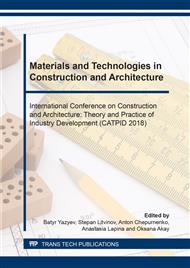p.14
p.19
p.24
p.30
p.36
p.42
p.47
p.54
p.60
Energy Model in Calculating the Strength Characteristics of the Reinforced Concrete Components
Abstract:
The article proposes applying energy from law deformation mechanics of the rigid body to deformation method for calculating the strength of reinforced concrete constructions with the use of diagrams illustrating the deformation of concrete and reinforcement. In terms of the energy theory of strength, concrete and rebar accumulate potential energy in the section of the construction component under stress; based on the contours of the diagram used in calculation it is possible to distinguish a stress diagram for concrete of the compressed zone. The value of the strains is equivalent to the force used for the deformation of the concrete specimen under stress (prism-or cylinder-shaped); the force is equal to the area used in the calculation of the normable diagram. The resolving balance equations are deduced with the use of the flat section hypothesis. The conditions of the stress balance in the section of the construction component are tested with the method of the successive approximation. The variable parameter of approximation is the construction component bending. General deformations (deflections) of the construction components are significantly higher than their limit stress values permitted for safe operation.
Info:
Periodical:
Pages:
36-41
Citation:
Online since:
September 2018
Authors:
Price:
Сopyright:
© 2018 Trans Tech Publications Ltd. All Rights Reserved
Share:
Citation:


